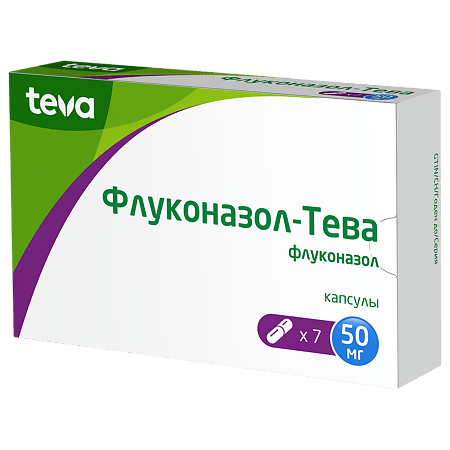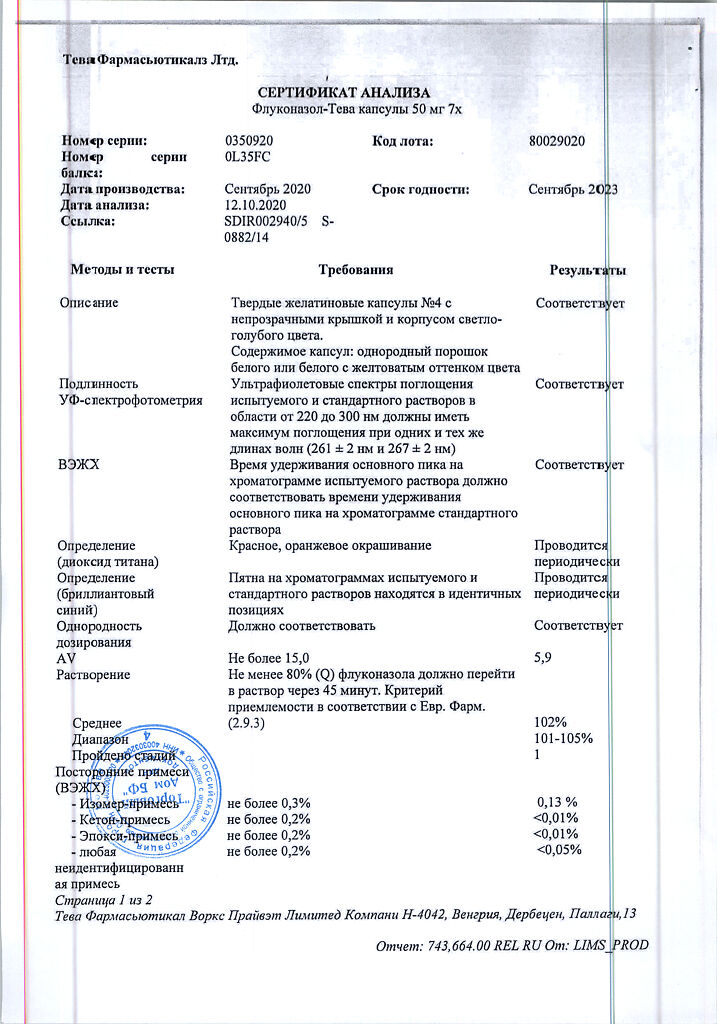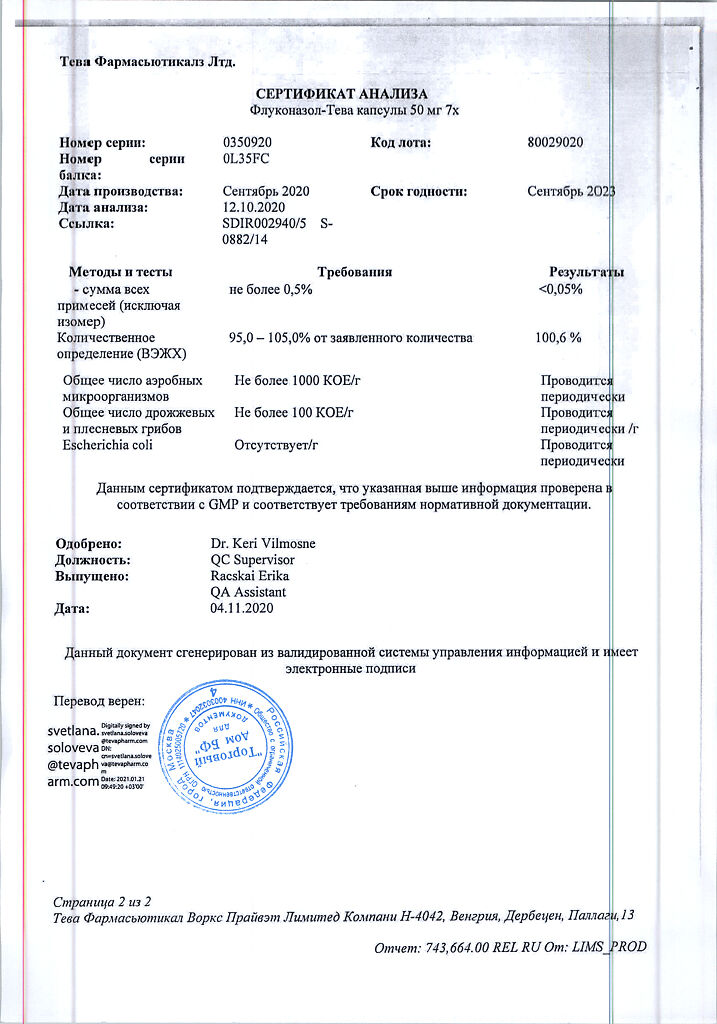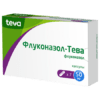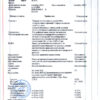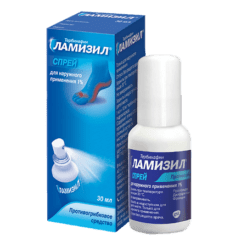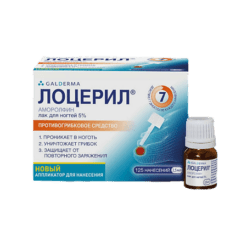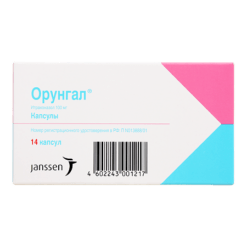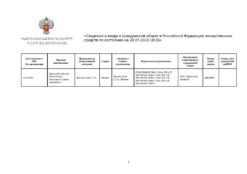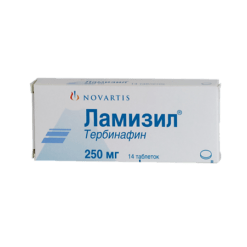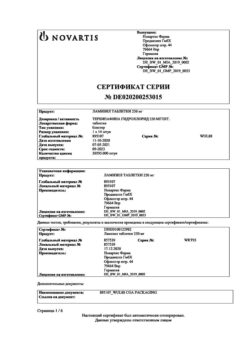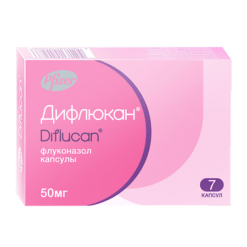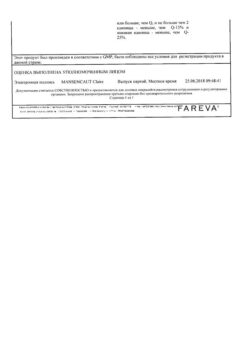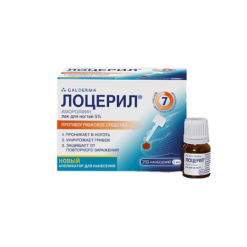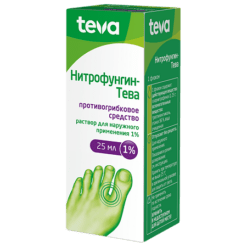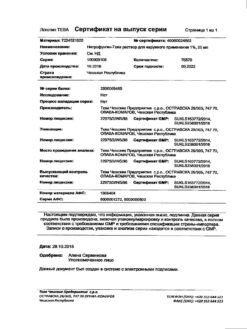No products in the cart.
Fluconazole-Teva, 50 mg capsules 7 pcs
€8.26 €7.23
Description
Pharmacotherapeutic group: antifungal agent
ATX code: J02AC01
Pharmacological properties
Pharmacodynamics
Fluconazole is a synthetic antifungal drug (antimycotic) of the
triazole derivatives, whose mechanism of action is associated with selective inhibition of ergosterol biosynthesis, essential for the formation of the cell membrane of fungi.
It shows activity in vitro and in clinical infections against most of the following microorganisms: Candida albicans, Candida glabrata (strains moderately sensitive), Candida pararsilosis, Candida tropicalis, Cryptococcus neoformans.
Active in vitro against the following microorganisms, but the clinical significance of this effect is unknown: Candida dubliniensis, Candida guilliermodii, Candida kefyr, Candida lusitaniae.
In oral administration, fluconazole shows activity in various models of fungal infections in animals: in opportunistic mycoses, including those caused by Candida spp (including generalized candidiasis in immunocompromised animals); Cryptococcus neoformans (including intracranial infections); Microsporum spp.
and Trychoptyton spp. The activity of the drug was also established in models of endemic mycoses in animals, including infections caused by Blastomyces dermatitides, Coccidioides immitis (including intracranial infections), and Histoplasma capsulatum in animals
with normal and suppressed immunity.
Fluconazole has high specificity against fungal enzymes
dependent on cytochrome P-450. Fluconazole therapy at a dose of 50 mg/day for up to 28 days has no effect on plasma testosterone concentrations in men or on steroid hormone concentrations in women of childbearing age. Fluconazole at a dose of 200-400 mg/day has no clinically significant effect on endogenous steroid blood levels and their response to adrenocorticotropic hormone (ACTH) stimulation in healthy male volunteers.
Mechanisms for the development of resistance to fluconazole.
Resistance to fluconazole may develop in the following cases: a qualitative or quantitative change in the enzyme lanosterol 14-α-demethylase, which is a target for fluconazole, decreased access to this enzyme by fluconazole, or a combination of these mechanisms.
Point mutations in the ERG11 gene encoding the target enzyme lead to a modification of the target and a decrease in affinity for chemical compounds from the azole group
(including triazole derivatives, which include fluconazole). Increased
expression of the ERG11 gene leads to high concentrations of the target enzyme, which creates a need to increase fluconazole concentrations in the intracellular fluid to inhibit all enzyme molecules in the cell.
The second significant mechanism of resistance is the active excretion
of fluconazole from the intracellular space through the activation of two types of transporters involved in the active excretion (efflux) of drugs from the fungal cell.
These transporters include a major mediator encoded by the MDR
(multidrug resistance) genes and a superfamily of ATP-binding transporters encoded by the CDR (Candida fungi resistance
genes to azole antimycotics) genes.
Hyperexpression of the MDR gene leads to resistance to fluconazole, while
overexpression of CDR genes can lead to resistance to various azoles.
Resistance to Candida glabrata is usually mediated by CDR gene hyperexpression, which leads to resistance to many antimycotics from the azole group. For those strains of fungi for which the minimum inhibitory concentration (MIC) is defined as intermediate (16-32 µg/ml), maximum doses of
fluconazole are recommended.
Candida krusei should be considered resistant to fluconazole. The mechanism of
resistance is related to the reduced sensitivity of its target enzyme
to the inhibitory effects of fluconazole.
Pharmacokinetics
The pharmacokinetics of fluconazole when taken orally is similar to the pharmacokinetics of
intravenous (IV) administration.
Absorption. After oral administration fluconazole is well absorbed, its concentration
in blood plasma (and overall bioavailability) exceeds 90% of the concentration of fluconazole
in blood plasma after intravenous administration. Simultaneous intake of food does not affect absorption of the drug when administered orally. Maximal concentration (Cmax) is reached in
0.5-1.5 hours after fluconazole administration on an empty stomach. The plasma concentration is proportional to the dose. If the recommended daily dose is taken once daily, the equilibrium concentration (Css) reaches 90% by the 4th-5th day of treatment with the drug. Administering a shock dose of 2 times the average daily dose on day 1 accelerates the attainment of 90% Css by day 2.
Dispensing. The amount of distribution approaches the total water content of the body. Binding to blood proteins is relatively low (11-12%).
Fluconazole penetrates well into many body fluids. Fluconazole concentrations in saliva, sputum, breast milk, joint fluid and peritoneal fluid are similar to its concentration in blood plasma. Constant values of concentration of the drug in vaginal secretion are reached after 8 hours after oral administration and are maintained at this level for at least 24 hours. In patients with fungal meningitis the concentration of fluconazole in cerebrospinal fluid is about 80% of its concentration in blood plasma. In the stratum corneum of the epidermis, epidermis-dermis and sweat fluid high concentrations of the drug are achieved that exceed serum concentrations. Fluconazole accumulates in the stratum corneum of the epidermis. When administered in a dose of 50 mg once daily, fluconazole concentration in this layer of skin after 12 days was 73 mcg/g, and after 7 days after discontinuation of treatment –
5.8 mcg/g. When used in a dose of 150 mg once a week, the concentration of fluconazole in the stratum corneum was 23.4 µg/g on day 7, and
7.1 µg/g 7 days after the second dose. The concentration of fluconazole in the nail plates after 4 months of use at a dose of 150 mg once/week was 4.05 µg/g in healthy nails and 1.8 µg/g in affected nails; 6 months after completion of therapy, fluconazole was still detected in the nail plates.
Metabolism and excretion. Fluconazole is excreted mainly by the kidneys; approximately 80% of the administered dose is found unchanged in the urine. Fluconazole clearance
is proportional to creatinine clearance. No drug metabolites were detected in blood. The long elimination half-life (T½) from plasma allows fluconazole
to be taken once for vaginal candidiasis and once daily or once/week for other indications.
Pharmacokinetics in selected patient groups
Pharmacokinetics in women during breastfeeding
. A pharmacokinetics study involving 10 women who temporarily or completely stopped breastfeeding assessed plasma and breast milk concentrations of fluconazole for 48 hours after a single dose of 150 mg of fluconazole.
Fluconazole was detected in breast milk at a mean concentration of
approximately 98% of the maternal plasma fluconazole concentration. The mean peak concentration was 2.61 mg/L after 5.2 hours of drug administration.
Pharmacokinetics in children
The following pharmacokinetic values were obtained in children:
Age | Dose | Half-life (hour) | The area under the concentration-time curve (AUC) (µg-h/ml) /td> | ||
9 months-13 years | Once – oral 2 mg/kg | 25.0 | 94.7 | ||
9 months-13 years | Once – oral 8 mg/kg |
362.5 | |||
Age | Dose | Half-life (hour) | Area under the concentration-time curve (AUC) (µg-h/ml) | ||
Mean age 7 years | Multiple times – oral 3mg/kg | 15.5 | 41.6 |
u>Pharmacokinetics in elderly patients
It was found that with a single oral dose of 50 mg of fluconazole
in elderly patients aged 65 years or older, some of whom were simultaneously taking diuretics, Cmax was reached 1.3 hours after ingestion and was 1.54 mcg/mL, mean AUC values were 76.4 ± 20.3 mcg-h/mL, and mean half-life was 46.2 hours. The values of these pharmacokinetic parameters are higher than in younger patients, which
is probably due to the reduced renal function characteristic of older age. Concomitant administration of diuretics did not cause significant changes in AUC and Cmax.
The creatinine clearance (74 mL/min), the percentage of fluconazole excreted by the kidneys
unchanged (0-24 hours, 22%) and the renal clearance of fluconazole (0.124 mL/min/kg) are lower in elderly patients compared with younger patients.
Indications
Indications
Fluconazole is indicated for the treatment of the following diseases in adults:
• Cryptococcal meningitis.
• Coccidioidomycosis.
• Invasive candidiasis.
• Mucous candidiasis, incl. oropharyngeal candidiasis, esophageal candidiasis, candiduria and chronic mucocutaneous candidiasis.
• Chronic atrophic candidiasis of the oral cavity (associated with wearing dentures), when maintaining oral hygiene or local treatment
not enough.
• Vaginal candidiasis, acute or recurrent, when local therapy
not applicable.
• Candidal balanitis, when local therapy is not applicable.
• Dermatomycoses, incl. dermatophytosis of the feet, dermatophytosis of the trunk, inguinal
dermatophytosis, pityriasis versicolor and cutaneous candidiasis when systemic treatment is indicated.
• Dermatophytosis of the nails (onychomycosis), when treated with other drugs
not acceptable.
Fluconazole is indicated for the prevention of the following diseases in adults:
• Recurrence of cryptococcal meningitis in patients at high risk of relapse.
• Recurrence of oropharyngeal candidiasis and esophageal candidiasis in HIV-infected patients with a high risk of relapse.
• To reduce the frequency of relapses of vaginal candidiasis (4 or more episodes
per year).
• For the prevention of candidal infections in patients with prolonged neutropenia (such as patients with hematologic malignancies undergoing chemotherapy or patients undergoing hematopoietic stem cell transplantation.
Fluconazole is indicated for use in children.
Fluconazole is used to treat mucosal candidiasis (oropharyngeal candidiasis and esophageal candidiasis), invasive candidiasis, cryptococcal meningitis, and the prevention of candidal infections in patients with weakened immune systems. Fluconazole can be used as maintenance therapy to prevent recurrence of cryptococcal meningitis in children at high risk of recurrence.
Pharmacological effect
Pharmacological effect
Pharmacotherapeutic group: antifungal agent
ATX code: J02AC01
Pharmacological properties
Pharmacodynamics
Fluconazole is a synthetic antifungal drug (antimycotic) from the group of triazole derivatives, the mechanism of action of which is associated with selective inhibition of the biosynthesis of ergosterol, necessary for the formation of the cell membrane of fungi.
Shows activity in vitro and in clinical infections against most of the following microorganisms: Candida albicans, Candida glabrata (moderately sensitive strains), Candida pararsilosis, Candida tropicalis, Cryptococcus neoformans.
It is active in vitro against the following microorganisms, but the clinical significance of this effect is unknown: Candida dubliniensis, Candida guilliermodii, Candida kefyr, Candida lusitaniae.
When administered orally, fluconazole exhibits activity in various models of fungal infections in animals: in opportunistic mycoses, including those caused by Candida spp. (including generalized candidiasis in immunosuppressed animals); Cryptococcus neoformans (including intracranial infections); Microsporum spp.
and Trychoptyton spp. The activity of the drug has also been established in models of endemic mycoses in animals, including infections caused by Blastomyces dermatitides, Coccidioides immitis (including intracranial infections), and Histoplasma capsulatum in animals with normal and suppressed immunity.
Fluconazole has high specificity for fungal enzymes,
dependent on cytochrome P-450. Fluconazole therapy at a dose of 50 mg/day for up to 28 days does not affect plasma testosterone concentrations in men or steroid hormone concentrations in women of childbearing age. Fluconazole at a dose of 200-400 mg/day does not have a clinically significant effect on the levels of endogenous steroids in the blood and their response to adrenocorticotropic hormone (ACTH) stimulation in healthy male volunteers.
Mechanisms of development of resistance to fluconazole.
Resistance to fluconazole can develop in the following cases: with a qualitative or quantitative change in the enzyme lanosteryl 14-α-demethylase, which is the target of fluconazole, decreased access to this enzyme by fluconazole, or a combination of these mechanisms.
Point mutations in the ERG11 gene, encoding the target enzyme, lead to a modification of the target and a decrease in affinity for chemical compounds from the azole group (including triazole derivatives, which include fluconazole). An increase in the expression of the ERG11 gene leads to the formation of high concentrations of the target enzyme, which creates the need to increase the concentration of fluconazole in the intracellular fluid to suppress all enzyme molecules in the cell.
The second significant mechanism of resistance is the active removal of fluconazole from the intracellular space due to the activation of two types of transporters involved in the active removal (efflux) of drugs from the fungal cell.
These transporters include the main messenger encoded by the MDR (multidrug resistance) genes and the superfamily of ATP-binding transporters encoded by the CDR genes (Candida azole antimycotic resistance genes).
Overexpression of the MDR gene leads to resistance to fluconazole, while overexpression of CDR genes can lead to resistance to various azoles.
Resistance to Candida glabrata is usually mediated by overexpression of the CDR gene, which leads to resistance to many azole antifungals. For those fungal strains for which the minimum inhibitory concentration (MIC) is determined to be intermediate (16-32 μg/ml), it is recommended to use the maximum dose of fluconazole.
Candida krusei should be considered resistant to fluconazole. The mechanism of resistance is associated with reduced sensitivity of its target enzyme to the inhibitory effects of fluconazole.
Pharmacokinetics
The pharmacokinetics of fluconazole when administered orally is similar to the pharmacokinetics when administered intravenously (IV).
Suction. After oral administration, fluconazole is well absorbed, its plasma concentration (and total bioavailability) exceeds 90% of the plasma concentration of fluconazole after intravenous administration. Concomitant food intake does not affect the absorption of the drug when taken orally. The maximum concentration (Cmax) is reached after
0.5-1.5 hours after taking fluconazole on an empty stomach. The concentration in blood plasma is proportional to the dose. When taking the recommended daily dose once a day, the equilibrium concentration (Css) reaches 90% by the 4-5th day of treatment with the drug. Administration of a loading dose on the 1st day, 2 times higher than the average daily dose, allows you to accelerate the achievement of Css equal to 90% by the 2nd day.
Distribution. The apparent volume of distribution approaches the total body water content. Binding to blood proteins is relatively low (11-12%).
Fluconazole penetrates well into many body fluids. The concentration of fluconazole in saliva, sputum, breast milk, joint fluid and peritoneal fluid is similar to its concentration in blood plasma. Constant concentrations of the drug in vaginal secretions are achieved 8 hours after oral administration and are maintained at this level for at least 24 hours. In patients with fungal meningitis, the concentration of fluconazole in the cerebrospinal fluid is about 80% of its concentration in the blood plasma. In the stratum corneum of the epidermis, epidermis-dermis and sweat fluid, high concentrations of the drug are achieved, which exceed serum concentrations. Fluconazole accumulates in the stratum corneum of the epidermis. When taken at a dose of 50 mg 1 time / day, the concentration of fluconazole in this layer of skin after 12 days was 73 mcg/g, and 7 days after stopping treatment – 5.8 mcg/g. When used at a dose of 150 mg once a week, the concentration of fluconazole in the stratum corneum of the skin on the 7th day was 23.4 mcg/g, and 7 days after taking the second dose –
7.1 µg/g. The concentration of fluconazole in the nail plates after 4 months of use at a dose of 150 mg once a week was 4.05 mcg/g in healthy nails and 1.8 mcg/g in affected nails; 6 months after completion of therapy, fluconazole was still detected in the nail plates.
Metabolism and excretion. Fluconazole is excreted primarily by the kidneys; approximately 80% of the administered dose is found unchanged in the urine. Fluconazole clearance is proportional to creatinine clearance. Metabolites of the drug were not detected in the blood. The long half-life (T½) from plasma allows fluconazole to be taken once for vaginal candidiasis and once a day or once a week for other indications.
Pharmacokinetics in selected patient groups
Pharmacokinetics in women during breastfeeding
In a pharmacokinetic study in 10 women who temporarily or completely stopped breastfeeding, fluconazole concentrations in plasma and breast milk were assessed for 48 hours after a single dose of 150 mg fluconazole.
Fluconazole has been detected in breast milk at an average concentration of approximately 98% of maternal plasma concentrations of fluconazole. The average peak concentration was 2.61 mg/L after 5.2 hours after dosing.
Pharmacokinetics in children
The following values of pharmacokinetic parameters were obtained in children:
Age
Dose
Half-life (hour)
Area under the concentration-time curve (AUC) (µg h/ml)
9 months-13 years
Single dose – orally 2 mg/kg
25.0
94.7
9 months-13 years
Single dose – orally 8 mg/kg
19.5
362.5
Age
Dose
Half-life (hour)
Area under the concentration-time curve (AUC) (µg h/ml)
Average age 7 years
Repeatedly – orally 3 mg/kg
15.5
41.6
Pharmacokinetics in elderly patients
It was found that with a single dose of fluconazole 50 mg orally
in elderly patients aged 65 years and older, some of whom were concomitantly taking diuretics, Cmax was achieved 1.3 hours after dosing and was 1.54 mcg/mL, mean AUC values were 76.4 ± 20.3 mcg·h/mL, and mean elimination half-life was 46.2 hours. The values of these pharmacokinetic parameters are higher than in young patients, which
probably associated with decreased renal function characteristic of old age. Concomitant use of diuretics did not cause a significant change in AUC and Cmax.
Creatinine clearance (74 ml/min), the percentage of fluconazole excreted unchanged by the kidneys (0-24 hours, 22%) and renal clearance of fluconazole (0.124 ml/min/kg) are lower in elderly patients compared to young patients.
Special instructions
Special instructions
Cases of superinfection caused by Candida strains other than Candida albicans, which often have intrinsic resistance to fluconazole (eg, Candida krusei and Candida auris) or reduced susceptibility (Candida glabrata), have been reported. In such cases, alternative antifungal therapy may be required.
During pregnancy, the use of fluconazole should be avoided, except in cases of severe and potentially life-threatening fungal infections when the expected benefit of treatment to the mother outweighs the possible risk to the fetus.
Effective methods of contraception should be considered in women of childbearing potential throughout the treatment period and for approximately one week (5-6 half-lives) after the last dose of the drug (see section “Use during pregnancy and breastfeeding”).
In rare cases, the use of fluconazole has been accompanied by toxic changes in the liver, including death, mainly in patients with serious concomitant diseases. In the case of hepatotoxic effects associated with the use of fluconazole, there was no obvious dependence on the total daily dose of the drug, duration of therapy, gender and age of the patient. The hepatotoxic effect of the drug was usually reversible; its signs disappeared after cessation of therapy. Patients whose liver function tests are impaired during treatment with the drug should be monitored for signs of more serious liver damage. If clinical signs or symptoms of liver damage appear that may be associated with the use of fluconazole, the drug should be discontinued.
As with other azoles, fluconazole can rarely cause anaphylactic reactions.
During treatment with fluconazole, patients have rarely developed exfoliative skin reactions such as Stevens-Johnson syndrome and toxic epidermal necrolysis. People with AIDS are more likely to develop severe skin reactions when taking many drugs. If a patient develops a rash during treatment for a superficial fungal infection that can be associated with the use of fluconazole, the drug should be discontinued. If a rash occurs in patients with invasive/systemic fungal infections, they should be closely monitored and the drug should be discontinued if bullous lesions or erythema multiforme develop.
Drug reaction with eosinophilia and systemic manifestations (DRESS syndrome) has been reported.
Concomitant use of fluconazole in doses less than 400 mg/day and terfenadine should be carried out under close supervision (see section “Interaction with other drugs”).
Like other azoles, fluconazole may cause prolongation of the QT interval on the ECG.
Fluconazole causes prolongation of the QT interval by inhibiting inward rectifying potassium channel current. Prolongation of the QT interval caused by other drugs (such as amiodarone) may be potentiated by inhibitors of cytochrome P450 isoenzyme 3A4 (CYP) (see section “Interactions with other drugs”). When using fluconazole, an increase in the QT interval and ventricular fibrillation/flutter were observed very rarely in patients with severe diseases with multiple risk factors, such as organic heart disease, electrolyte imbalances and concomitant medications that contribute to the development of such disorders. An increased risk of developing life-threatening ventricular arrhythmias and polymorphic ventricular tachycardia may occur in patients with hypokalemia and progressive heart failure. Therefore, fluconazole should be used with caution in such patients with potentially proarrhythmic conditions.
For patients with liver, heart and kidney diseases before using the drug
It is recommended to consult a doctor. When using fluconazole 150 mg for vaginal candidiasis, patients should be warned that improvement of symptoms is usually observed after 24 hours, but sometimes takes several days for complete resolution. If symptoms persist for several days, you should consult a doctor.
Evidence of the effectiveness of fluconazole in the treatment of other types of endemic mycoses, such as paracoccidioidomycosis, sporotrichosis, histoplasmosis, is limited, which does not allow specific dosing recommendations to be determined. Fluconazole is a moderate inhibitor of the CYP2C9 isoenzyme and a moderate inhibitor of the CYP3A4 isoenzyme. Fluconazole is also an inhibitor of the CYP2C19 isoenzyme. With simultaneous therapy with drugs with a narrow therapeutic profile,
metabolized by isoenzymes CYP2C9, CYP2C19 and CYP3A4, caution is recommended (see section “Interaction with other drugs”).
Adrenal insufficiency has been reported in patients receiving therapy with other azoles (eg, ketoconazole). Reversible cases of adrenal insufficiency have been observed in patients receiving fluconazole.
Impact on the ability to drive vehicles and machinery
When using the drug, it is necessary to take into account the possibility of developing dizziness and convulsions.
Active ingredient
Active ingredient
Fluconazole
Composition
Composition
1 capsule contains: active ingredient fluconazole 50.00 mg, 100.00 mg or 150.00 mg; excipients: lactose monohydrate 47.00/94.00/141.00 mg,
corn starch 16.65/33.30/49.95 mg, colloidal anhydrous silicon dioxide 0.1125/0.225/0.3375 mg, sodium lauryl sulfate 0.1125/0.225/0.3375 mg, magnesium stearate 1.125/2.25/3.375 mg.
Gelatin capsule: body: titanium dioxide (E171) 0.46/0.73/0.91 mg, brilliant blue dye FCF (E133) -/-/0.015 mg, gelatin q.s. up to 22.8/q.s. up to 36.6/q.s. up to 45.6 mg; cap: titanium dioxide (E171) 0.30/0.73/0.61 mg, brilliant blue dye FCF (E133) 0.005/0.056/0.010 mg, gelatin q.s. up to 15.2/q.s. up to 24.4/q.s. up to 30.4 mg.
Pregnancy
Pregnancy
There have been no adequate and controlled studies of the use of fluconazole in pregnant women.
During pregnancy, the use of fluconazole should be avoided, except in cases of severe and potentially life-threatening fungal infections when the expected benefit of treatment to the mother outweighs the possible risk to the fetus.
Effective methods of contraception should be considered in women of childbearing potential throughout the treatment period and for approximately one week (5-6 half-lives) after the last dose of the drug (see section “Pharmacokinetics”).
Data from several thousand pregnant women receiving a cumulative dose of fluconazole <150 mg in the first trimester do not show an increase in the overall risk of fetal malformations. In one large observational cohort study, oral fluconazole use in the first trimester was associated with a small increase in the risk of musculoskeletal malformations, corresponding to approximately 1 additional case per 1000 women receiving cumulative doses of <450 mg compared with women receiving topical azoles, and approximately 4 additional cases per 1000 women receiving cumulative doses greater than 450 mg. The adjusted relative risk was 1.29 (95% CI 1.05–1.58) for 150 mg oral fluconazole and 1.98 (95% CI 1.23–3.17) for fluconazole doses greater than 450 mg.Cases of spontaneous abortion and the development of congenital anomalies have been reported in infants whose mothers used fluconazole 150 mg once or repeatedly in the first trimester of pregnancy. Cases of multiple congenital malformations have been described in newborns whose mothers received high-dose fluconazole therapy (400-800 mg/day) for most or all of the first trimester. The following developmental disorders were noted: brachycephaly, impaired development of the facial part of the skull, impaired formation of the cranial vault, cleft palate, curvature of the femurs, thinning and elongation of the ribs, arthrogryposis and congenital heart defects.Fluconazole is found in breast milk in concentrations close to plasma concentrations (see section “Pharmacokinetics”). The half-life of the drug from breast milk is approximately equal to the half-life from plasma – 30 hours. The estimated dosage of fluconazole absorbed by the infant (assuming an average milk intake of 150 mL/kg daily) and calculated according to the average peak drug concentration in breast milk is 0.39 mg/kg per day, which is approximately 40% of the recommended neonatal dose (for infants <2 weeks of age) or 13% of the recommended infant dose for the treatment of mucosal candidiasis.Breastfeeding can be continued after taking a single dose of fluconazole 150 mg. It is not recommended to breast-feed after multiple or high dose doses of fluconazole. When deciding whether to prescribe Fluconazole-Teva while breastfeeding, the following factors should be taken into account: the benefits of breastfeeding for the health and development of the infant, together with the clinical indications for prescribing Fluconazole-Teva and the possibility of developing any potential side effects in the infant or the impact of concomitant maternal pathology on the health of the infant.
Contraindications
Contraindications
• Hypersensitivity to fluconazole, other components of the drug or substances with an azole-containing chemical structure similar to fluconazole;
• simultaneous use of terfenadine during repeated use of fluconazole at a dose of 400 mg/day or more (see section “Interaction with other drugs”);
• simultaneous use with drugs that increase the QT interval and are metabolized by the CYP3A4 isoenzyme, such as cisapride, astemizole, erythromycin, pimozide and quinidine (see section “Interaction with other drugs”);
• galactose intolerance, lactase deficiency and glucose/galactose malabsorption;
• children under 3 years of age (for this dosage form).
With caution
• liver failure;
• renal failure;
• the appearance of a rash during the use of fluconazole in patients with superficial fungal infection and invasive / systemic fungal infections;
• simultaneous use of terfenadine and fluconazole at a dose of less than 400 mg/day;
• potentially proarrhythmic conditions in patients with multiple risk factors (organic heart disease, electrolyte imbalance and concomitant therapy that contributes to the development of such disorders).
Side Effects
Side Effects
The incidence of adverse reactions is estimated as follows: very common (≥1/10), common (≥1/100 to ˂1/10), uncommon (≥1/1000 to ˂1/100), rare (≥1/10,000 to ˂1/1000), very rare (˂1/10,000), frequency unknown (cannot be estimated by available data).
The drug is usually well tolerated.
In clinical and post-marketing (*) studies of fluconazole, the following adverse reactions were noted:
From the nervous system: often – headache; uncommon – dizziness*, convulsions*, changes in taste*, paresthesia, insomnia, drowsiness; rarely – tremor.
From the digestive system: often – abdominal pain, diarrhea, nausea, vomiting*; uncommon – flatulence, dyspepsia*, dry oral mucosa, constipation.
From the hepatobiliary system: often – increased serum activity of aminotransferases (alanine aminotransferase (ALT) and aspartate aminotransferase (AST)), alkaline phosphatase; uncommon – cholestasis, jaundice*, increased bilirubin concentration; rarely – hepatotoxicity, in some cases fatal, liver dysfunction*, hepatitis*, hepatocellular necrosis*, hepatocellular damage.
From the skin: often – rash; uncommon – skin itching, urticaria, increased sweating, drug rash (including persistent drug rash);
rarely – exfoliative skin lesions*, including Stevens-Johnson syndrome and toxic epidermal necrolysis, acute generalized exanthematous pustulosis, facial edema, alopecia*, frequency unknown – drug rash with eosinophilia and
systemic manifestations (DRESS syndrome).
From the hematopoietic organs and lymphatic system*: rarely – leukopenia, including neutropenia and agranulocytosis, thrombocytopenia, anemia.
From the immune system*: anaphylaxis (including angioedema).
From the cardiovascular system*: rarely – an increase in the QT interval on the ECG, ventricular tachysystolic arrhythmia of the “pirouette” type (torsade de pointes) (see section “Special instructions”).
Metabolism*: rarely – increased concentrations of cholesterol and triglycerides in the blood plasma, hypokalemia.
From the musculoskeletal system: infrequently – myalgia.
Other: infrequently – weakness, asthenia, increased fatigue, fever, vertigo.
In some patients, especially those suffering from serious diseases such as AIDS or cancer, changes in blood counts, kidney and liver function were observed during treatment with Fluconazole-Teva and similar drugs (see section “Special Instructions”), but the clinical significance of these changes and their relationship with treatment have not been established.
Interaction
Interaction
Single or multiple doses of fluconazole at a dose of 50 mg do not affect the metabolism of phenazone (Antipyrin) when used simultaneously.
Concomitant use of fluconazole with the following drugs
contraindicated:
Cisapride: with the simultaneous use of fluconazole and cisapride, adverse reactions from the heart are possible, incl. ventricular fibrillation/flutter (torsade de pointes). Use of fluconazole at a dose of 200 mg once a day and cisapride at a dose of 20 mg
4 times a day leads to a marked increase in plasma concentrations of cisapride and an increase in the QT interval on the ECG. Concomitant use of cisapride and fluconazole is contraindicated.
Terfenadine: When azole antifungals are used concomitantly with terfenadine, serious arrhythmias may occur as a result of prolongation of the QT interval. When taking fluconazole at a dose of 200 mg/day, an increase in the QT interval has not been established, however, the use of fluconazole at doses of 400 mg/day and above causes a significant increase in the concentration of terfenadine in plasma. Concomitant use of fluconazole
in doses of 400 mg/day or more with terfenadine is contraindicated (see section “Contraindications”). Treatment with fluconazole in doses less than 400 mg/day in combination with terfenadine
should be carried out under close supervision.
Astemizole: simultaneous use of fluconazole with astemizole or other drugs metabolized by the cytochrome P450 system may be accompanied by an increase in serum concentrations of these drugs. Elevated concentrations of astemizole in blood plasma can lead to prolongation of the QT interval and, in some cases, to the development of ventricular tachysystolic arrhythmia of the “pirouette” type (torsade de pointes). The simultaneous use of astemizole and fluconazole is contraindicated.
Pimozide: Although adequate in vitro or in vivo studies have not been conducted, concomitant use of fluconazole and pimozide may result in inhibition of the metabolism of pimozide. In turn, an increase in plasma concentrations of pimozide can lead to a prolongation of the QT interval and, in some cases, to the development of torsades de pointes. The simultaneous use of pimozide and fluconazole is contraindicated.
Quinidine: Although adequate in vitro or in vivo studies have not been conducted, concomitant use of fluconazole and quinidine may result in inhibition of quinidine metabolism. In turn, an increase in plasma concentrations of quinidine can lead to a prolongation of the QT interval and, in some cases, to the development of torsade de pointes (TdP). The simultaneous use of quinidine and fluconazole is contraindicated.
Erythromycin: Concomitant use of fluconazole and erythromycin potentially leads to an increased risk of cardiotoxicity (QT prolongation, torsade de pointes) and, consequently, sudden cardiac arrest. The simultaneous use of fluconazole and erythromycin is contraindicated.
The following medications are not recommended:
Halofantrine: Fluconazole may increase plasma concentrations of halofantrine
blood due to inhibition of the CYP3A4 isoenzyme. Concomitant use of fluconazole and halofantrine may increase the risk of cardiotoxicity (QT prolongation, torsade de pointes) and, consequently, sudden cardiac arrest. Concomitant use of fluconazole and halofantrine is not recommended.
Caution should be exercised when used simultaneously with fluconazole:
Amiodarone: Amiodarone has been associated with QT prolongation.
Caution should be exercised when using fluconazole and
simultaneously.
amiodarone, especially when taking a high dose of fluconazole (800 mg).
Caution and possible dosage adjustments should be used when the following drugs are used concomitantly with fluconazole:
Drugs that affect the metabolism and effects of fluconazole:
Hydrochlorothiazide: Repeated use of hydrochlorothiazide concomitantly with fluconazole results in an increase in plasma concentrations of fluconazole by 40%. An effect of this severity does not require a change in the dosage regimen of fluconazole
in patients receiving concomitant diuretics, however, the physician should take this into account.
Rifampicin: simultaneous use of fluconazole and rifampicin leads to
to a decrease in AUC by 25% and the half-life of fluconazole by 20%.
In patients concomitantly taking rifampicin, the advisability of increasing the dose of fluconazole must be considered.
Drugs whose action is influenced by fluconazole:
Fluconazole is a moderate inhibitor of CYP3A4 and CYP2C9 isoenzymes
cytochrome P450. Fluconazole is also an inhibitor of CYP2C19 isoenzymes. In addition, there is a risk of increased plasma concentrations of other drugs metabolized by the CYP2C9, CYP2C19 and CYP3A4 isoenzymes when taken simultaneously with fluconazole. In this regard, caution should be exercised when using these drugs simultaneously, and if such combinations are necessary, patients should be under close medical supervision. It should be taken into account that the inhibitory effect of fluconazole persists for 4-5 days after discontinuation of the drug due to the long half-life.
Alfentanil: There is a decrease in clearance and volume of distribution, and an increase in the half-life of alfentanil. This may be due to inhibition of the CYP3A4 isoenzyme by fluconazole. Alfentanil dosage adjustment may be required.
Amitriptyline, nortriptyline: increased effect. Concentrations of 5-nortriptyline and/or S-amitriptyline can be measured at the start of combination therapy with fluconazole and one week after initiation. If necessary, the dose of amitriptyline/nortriptyline should be adjusted.
Amphotericin B: In studies in mice (including immunosuppressed mice), the following results were observed: a small additive antifungal effect in systemic infection with Candida albicans, no interaction in intracranial infection with Cryptococcus neoformans, and antagonism in systemic infection with Aspergillus fumigatus. Clinical significance of these results
not clear.
Anticoagulants: like other antifungal agents from the group of azole derivatives, fluconazole, when used simultaneously with warfarin, increases prothrombin time (by 12%), and therefore bleeding may develop (hematomas, bleeding from the nose and gastrointestinal tract, hematuria, melena). In patients receiving coumarin or indanedione anticoagulants and fluconazole, prothrombin time should be continuously monitored during therapy and for 8 days after cessation of concomitant use. The feasibility of adjusting the dose of anticoagulants should also be assessed.
Azithromycin: with simultaneous oral use of fluconazole in a single dose of 800 mg with azithromycin in a single dose of 1200 mg, no pronounced pharmacokinetic interaction has been established between both drugs.
Benzodiazepines (short-acting): after oral midazolam, fluconazole
significantly increases the concentration of midazolam and psychomotor effects, and this effect is more pronounced after taking fluconazole orally than when using it intravenously. If concomitant therapy with benzodiazepines is necessary, patients taking fluconazole should be monitored for an appropriate reduction in the benzodiazepine dose. When coadministered with a single dose of triazolam, fluconazole increases triazolam AUC by approximately 50%, Cmax by 25-32% and T1/2 by 25-50% due to inhibition of triazolam metabolism. Dose adjustment may be necessary
triazolam.
Carbamazepine: Fluconazole inhibits the metabolism of carbamazepine and increases the serum concentration of carbamazepine by 30%. The risk of carbamazepine toxicity must be taken into account. The need for carbamazepine dosage adjustment should be assessed
depending on concentration/effect.
Nevirapine: Coadministration of fluconazole and nevirapine increased nevirapine exposure by approximately 100% compared with control data for nevirapine alone. Due to the risk of increased excretion of nevirapine during concomitant use of drugs, some precautions and careful monitoring of patients are necessary.
Calcium channel blockers: Some calcium channel antagonists (nifedipine, isradipine, amlodipine, verapamil and felodipine) are metabolized by the CYP3A4 isoenzyme. Fluconazole increases systemic exposure to calcium antagonists
channels. Monitoring for the development of side effects is recommended.
Cyclosporine: In patients with a kidney transplant, the use of fluconazole at a dose of 200 mg/day leads to a slow increase in cyclosporine concentrations. However, with repeated doses of fluconazole at a dose of 100 mg/day, no changes in cyclosporine concentrations were observed in bone marrow recipients. When using fluconazole and cyclosporine simultaneously, it is recommended to monitor the concentration of cyclosporine in the blood.
Cyclophosphamide: with simultaneous use of cyclophosphamide and fluconazole, an increase in serum concentrations of bilirubin and creatinine is observed. This combination is acceptable given the risk of increased bilirubin and creatinine concentrations.
Fentanyl: There has been a report of one death possibly related to the concomitant use of fentanyl and fluconazole. The disturbances are believed to be related to fentanyl intoxication. Fluconazole has been shown to significantly prolong the clearance time of fentanyl. It should be borne in mind that an increase in the concentration of fentanyl can lead to depression of respiratory function.
HMG-CoA reductase inhibitors: When fluconazole is used concomitantly with HMG-CoA reductase inhibitors metabolized by the CYP3A4 isoenzyme (such as atorvastatin and simvastatin) or the CYP2D6 isoenzyme (such as fluvastatin), the risk of developing myopathy and rhabdomyolysis increases. If simultaneous therapy with these drugs is necessary, patients should be monitored to identify symptoms of myopathy and rhabdomyolysis. It is necessary to monitor the concentration of creatinine kinase. If there is a significant increase in creatinine kinase concentrations or if myopathy or rhabdomyolysis is diagnosed or suspected, therapy with HMG-CoA reductase inhibitors should be discontinued.
Losartan: Fluconazole inhibits the metabolism of losartan to its active metabolite
(E-3174), which is responsible for most of the effects associated with angiotensin II receptor antagonism. Regular monitoring of blood pressure is necessary.
Methadone: Fluconazole may increase plasma concentrations of methadone. Methadone dosage adjustment may be necessary.
Nonsteroidal anti-inflammatory drugs (NSAIDs): Flurbiprofen Cmax and AUC increased by 23% and 81%, respectively. Similarly, the Cmax and AUC of the pharmacologically active isomer [S-(+)-ibuprofen] increased by 15% and 82%, respectively, when fluconazole was coadministered with racemic ibuprofen (400 mg).
With simultaneous use of fluconazole at a dose of 200 mg/day and celecoxib at a dose of
200 mg, Cmax and AUC of celecoxib increased by 68% and 134%, respectively.
In this combination, it is possible to reduce the dose of celecoxib by half.
Although there are no targeted studies, fluconazole may increase the systemic exposure of other NSAIDs metabolized by the CYP2C9 isoenzyme (for example, naproxen, lornoxicam, meloxicam, diclofenac). May be needed
NSAID dose adjustment.
When NSAIDs and fluconazole are used concomitantly, patients should be closely monitored medically to identify and monitor NSAID-related adverse events and toxicities.
Olaparib: moderate CYP3A4 inhibitors such as fluconazole,
increase the concentration of olaparib in the blood plasma. Their simultaneous use is not recommended. If simultaneous use cannot be avoided,
reduce the dose of olaparib to 200 mg twice daily.
Oral contraceptives: with simultaneous use of a combined oral contraceptive with fluconazole at a dose of 50 mg, no significant effect on hormone levels has been established, while with daily administration of 200 mg of fluconazole, the AUC of ethinyl estradiol and levonorgestrel increases by 40% and 24%, respectively,
and when fluconazole 300 mg was administered once weekly, the AUCs of ethinyl estradiol and norethindrone increased by 24% and 13%, respectively. Thus, repeated use of fluconazole in the indicated doses is unlikely to affect the effectiveness
combined oral contraceptive.
Phenytoin: Concomitant use of fluconazole and phenytoin may be accompanied by a clinically significant increase in phenytoin concentrations. If concomitant use of both drugs is necessary, phenytoin concentrations should be monitored and the dose adjusted accordingly to ensure therapeutic serum concentrations.
Prednisone: there is a report of the development of acute adrenal insufficiency in a patient after liver transplantation while fluconazole was discontinued after a three-month course of therapy. Presumably, cessation of fluconazole therapy caused an increase in the activity of the CYP3A4 isoenzyme, which led to increased metabolism
prednisone.
Patients receiving combination therapy with prednisone and fluconazole,
should be under close medical supervision when discontinuing treatment
fluconazole to assess the condition of the adrenal cortex.
Rifabutin: Concomitant use of fluconazole and rifabutin can lead to an increase in serum concentrations of the latter by up to 80%. Cases of uveitis have been described with the simultaneous use of fluconazole and rifabutin. Sick, at the same time
patients receiving rifabutin and fluconazole should be monitored closely.
Saquinavir: AUC increases by approximately 50%, Cmax by 55%, clearance of saquinavir decreases by approximately 50% due to inhibition of hepatic
metabolism of the CYP3A4 isoenzyme and inhibition of P-glycoprotein. Maybe
saquinavir dose adjustment will be necessary.
Sirolimus: increased plasma concentrations of sirolimus, presumably due to inhibition of sirolimus metabolism through inhibition of the CYP3A4 isoenzyme and P-glycoprotein. This combination can be used with appropriate dose adjustment of sirolimus depending on the effect/concentration.
Sulfonylureas: Fluconazole, when administered concomitantly with sulfonylureas, increases the half-life of oral sulfonylureas (chlorpropamide, glibenclamide, glipizide and tolbutamide). Patients with diabetes mellitus can be prescribed the combined use of fluconazole and oral sulfonylureas, but this should be taken into account
the possibility of developing hypoglycemia, in addition, regular monitoring is necessary
blood glucose and, if necessary, dose adjustment of sulfonylurea drugs.
Tacrolimus: simultaneous use of fluconazole and tacrolimus (orally) leads to
to increase serum concentrations of the latter by 5 times due to inhibition
metabolism of tacrolimus occurring in the intestine via the CYP3A4 isoenzyme. No significant changes in the pharmacokinetics of the drugs were observed when tacrolimus was administered intravenously. Cases of nephrotoxicity have been described. Patients receiving tacrolimus and fluconazole concomitantly should be monitored closely. The dose of tacrolimus should be adjusted depending on the degree of increase in its concentration in the blood.
Theophylline: when used simultaneously with fluconazole at a dose of 200 mg for
After 14 days, the average rate of plasma clearance of theophylline decreases by 18%.
When prescribing fluconazole to patients taking high doses of theophylline or to patients at increased risk of developing theophylline toxicity, monitor for symptoms of theophylline overdose and, if necessary, adjust therapy accordingly.
Tofacitinib: The exposure of tofacitinib is increased when it is co-administered with drugs that are both moderate inhibitors of CYP3A4 and CYP2C19 isoenzymes (for example, fluconazole). A dose adjustment of tofacitinib may be necessary.
Vinca alkaloid: Although focused studies are lacking, it is suggested that fluconazole may increase plasma concentrations of vinca alkaloids (e.g., vincristine and vinblastine) and thus lead to neurotoxicity, which may be due to inhibition of the CYP3A4 isoenzyme.
Vitamin A: There is a message about one case of the development of undesirable reactions from the central nervous system (central nervous system) in the form of a pseudo-pupport of the brain while using completely trans-reservoic acid and fluconazole, which disappeared after the cancellation of fluconazole. The use of this combination is possible, but it should be remembered about the possibility of unwanted reactions from the central nervous system.
Zidovudin: With the simultaneous use with fluconazole, an increase in CMAX and AUC Zidovudin is 84 % and 74 %, respectively. This effect is probably due to a decrease in the metabolism of the latter to its main metabolite. Before and after therapy with the use of fluconazole at a dose of 200 mg/day for 15 days, patients with AIDS and ARC (AIDS complex) have a significant increase in AUC
Zidovudin (20 %). Patients receiving such a combination should be observed in order to detect side effects of Zidovudin.
Voriconazole (inhibitor of the isoenzymes SYR2S9, CYP2C19 and CYR3A4): simultaneous use of a toriconazole (400 mg 2 times a day on the first day, then 200 mg twice a day for 2.5 days) and fluconazole (400 mg on the first day, then 200 mg per day for 4 days) leads to an increase in concentration and AUC Voriconazole by 57 % and 79 %, respectively. It was shown that this effect is preserved with a decrease in the dose and/or a decrease in the multiplicity of taking any of the drugs. The simultaneous use of funazol and fluconazole is not recommended.
Ivakaftor: with the simultaneous use with Ivacafator, the stimulator of the cystic fibrous transmembrane conduction regulator (CFTR), an increase in the Ivacafter exposition by 3 times and the exposition of hydroxymethyl-idi-coat (M1) by 1.9 times was observed. Patients who simultaneously take moderate SYR3A inhibitors, such as fluconazole and erythromycin, are recommended to reduce the dose of Ivacafator to 150 mg once
per day.
Studies of the interaction of oral forms of fluconazole with its simultaneous intake with food, cimetidin, antacids, as well as after total irradiation of the body to prepare for bone marrow transplantation, showed that these factors do not have a clinically significant effect on the absorption of fluconazole.
The listed interactions are established with multiple use of fluconazole; Interactions with drugs as a result of a single use of fluconazole are not known.
Doctors should take into account that interaction with other drugs has not been specially studied, but it is possible.
Overdose
Overdose
There have been reports of fluconazole overdose. In one case, a 42-year-old patient infected with the human immunodeficiency virus developed hallucinations and paranoid behavior after taking 8200 mg of the drug. The patient was hospitalized; his condition returned to normal within 48 hours.
In case of overdose, an adequate effect can be achieved with symptomatic treatment (including supportive measures and gastric lavage).
Fluconazole is excreted primarily in the urine, so forced diuresis is likely to speed up the elimination of the drug from the body. A 3-hour hemodialysis session reduces plasma fluconazole levels by approximately 50%.
Storage conditions
Storage conditions
Store at a temperature not exceeding 25 °C.
Keep out of the reach of children!
Shelf life
Shelf life
3 years.
Do not use after expiration date.
Manufacturer
Manufacturer
Teva Pharmaceutical Works Private Limited Company, Hungary
Additional information
| Shelf life | 3 years. Do not use after the expiration date. |
|---|---|
| Conditions of storage | Store at a temperature not exceeding 25 °C. Keep out of reach of children! |
| Manufacturer | Teva Pharmaceutical Works Production Limited Company, Hungary |
| Medication form | capsules |
| Brand | Teva Pharmaceutical Works Production Limited Company |
Related products
Buy Fluconazole-Teva, 50 mg capsules 7 pcs with delivery to USA, UK, Europe and over 120 other countries.

